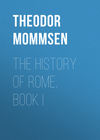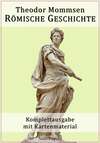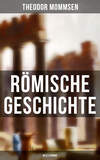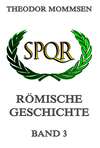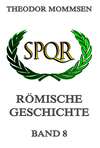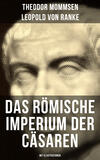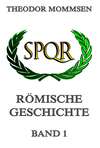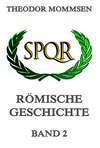Buch lesen: «The History of Rome, Book I», Seite 15
The same distinctive character was manifest, moreover, in the domain of its practical use. The practical gain which accrued to the Roman community from their religion was a code of moral law gradually developed by the priests, and the -Pontifices- in particular, which on the one hand supplied the place of police regulations at a time when the state was still far from providing any direct police-guardianship for its citizens, and on the other hand brought to the bar of the gods and visited with divine penalties the breach of moral obligations. To the regulations of the former class belonged the religious inculcation of a due observance of holidays and of a cultivation of the fields and vineyards according to the rules of good husbandry—which we shall have occasion to notice more fully in the sequel—as well as the worship of the heath or of the Lares which was connected with considerations of sanitary police,112 and above all the practice of burning the bodies of the dead, adopted among the Romans at a singularly early period, far earlier than among the Greeks—a practice implying a rational conception of life and of death, which was foreign to primitive times and is even foreign to ourselves at the present day. It must be reckoned no small achievement that the national religion of the Latins was able to carry out these and similar improvements. But the civilizing effect of this law was still more important. If a husband sold his wife, or a father sold his married son; if a child struck his father, or a daughter-in-law her father-in-law; if a patron violated his obligation to keep faith with his guest or dependent; if an unjust neighbour displaced a boundary-stone, or the thief laid hands by night on the grain entrusted to the common good faith; the burden of the curse of the gods lay thenceforth on the head of the offender. Not that the person thus accursed (-sacer-) was outlawed; such an outlawry, inconsistent in its nature with all civil order, was only an exceptional occurrence—an aggravation of the religious curse in Rome at the time of the quarrels between the orders. It was not the province of the individual burgess, or even of the wholly powerless priest, to carry into effect such a divine curse. Primarily the person thus accursed became liable to the divine penal judgment, not to human caprice; and the pious popular faith, on which that curse was based, must have had power even over natures frivolous and wicked. But the banning was not confined to this; the king was in reality entitled and bound to carry the ban into execution, and, after the fact, on which the law set its curse, had been according to his conscientious conviction established, to slay the person under ban, as it were, as a victim offered up to the injured deity (-supplicium-), and thus to purify the community from the crime of the individual. If the crime was of a minor nature, for the slaying of the guilty there was substituted a ransom through the presenting of a sacrificial victim or of similar gifts. Thus the whole criminal law rested as to its ultimate basis on the religious idea of expiation.
But religion performed no higher service in Latium than the furtherance of civil order and morality by such means as these. In this field Hellas had an unspeakable advantage over Latium; it owed to its religion not merely its whole intellectual development, but also its national union, so far as such an union was attained at all; the oracles and festivals of the gods, Delphi and Olympia, and the Muses, daughters of faith, were the centres round which revolved all that was great in Hellenic life and all in it that was the common heritage of the nation. And yet even here Latium had, as compared with Hellas, its own advantages. The Latin religion, reduced as it was to the level of ordinary perception, was completely intelligible to every one and accessible in common to all; and therefore the Roman community preserved the equality of its citizens, while Hellas, where religion rose to the level of the highest thought, had from the earliest times to endure all the blessing and curse of an aristocracy of intellect. The Latin religion like every other had its origin in the effort of faith to fathom the infinite; it is only to a superficial view, which is deceived as to the depth of the stream because it is clear, that its transparent spirit-world can appear to be shallow. This fervid faith disappeared with the progress of time as necessarily as the dew of morning disappears before the rising sun, and thus the Latin religion came subsequently to wither; but the Latins preserved their simplicity of belief longer than most peoples and longer especially than the Greeks. As colours are effects of light and at the same time dim it, so art and science are not merely the creations but also the destroyers of faith; and, much as this process at once of development and of destruction is swayed by necessity, by the same law of nature certain results have been reserved to the epoch of early simplicity—results which subsequent epochs make vain endeavours to attain. The mighty intellectual development of the Hellenes, which created their religious and literary unity (ever imperfect as that unity was), was the very thing that made it impossible for them to attain to a genuine political union; they sacrificed thereby the simplicity, the flexibility, the self-devotion, the power of amalgamation, which constitute the conditions of any such union. It is time therefore to desist from that childish view of history which believes that it can commend the Greeks only at the expense of the Romans, or the Romans only at the expense of the Greeks; and, as we allow the oak to hold its own beside the rose, so should we abstain from praising or censuring the two noblest organizations which antiquity has produced, and comprehend the truth that their distinctive excellences have a necessary connection with their respective defects. The deepest and ultimate reason of the diversity between the two nations lay beyond doubt in the fact that Latium did not, and that Hellas did, during the season of growth come into contact with the East. No people on earth was great enough by its own efforts to create either the marvel of Hellenic or at a later period the marvel of Christian culture; history has produced these most brilliant results only where the ideas of Aramaic religion have sunk into an Indo-Germanic soil. But if for this reason Hellas is the prototype of purely human, Latium is not less for all time the prototype of national, development; and it is the duty of us their successors to honour both and to learn from both.
Foreign Worships
Such was the nature and such the influence of the Roman religion in its pure, unhampered, and thoroughly national development. Its national character was not infringed by the fact that, from the earliest times, modes and systems of worship were introduced from abroad; no more than the bestowal of the rights of citizenship on individual foreigners denationalized the Roman state. An exchange of gods as well as of goods with the Latins in older time must have been a matter of course; the transplantation to Rome of gods and worships belonging to less cognate races is more remarkable. Of the distinctive Sabine worship maintained by the Tities we have already spoken.113 Whether any conceptions of the gods were borrowed from Etruria is more doubtful: for the Lases, the older designation of the genii (from -lascivus-), and Minerva the goddess of memory (-mens-, -menervare-), which it is customary to describe as originally Etruscan, were on the contrary, judging from philological grounds, indigenous to Latium. It is at any rate certain, and in keeping with all that we otherwise know of Roman intercourse that the Greek worship received earlier and more extensive attention in Rome than any other of foreign origin. The Greek oracles furnished the earliest occasion of its introduction. The language of the Roman gods was on the whole confined to Yea and Nay or at the most to the making their will known by the method of casting lots, which appears in its origin Italian;114 while from very ancient times—although not apparently until the impulse was received from the East—the more talkative gods of the Greeks imparted actual utterances of prophecy. The Romans made efforts, even at an early period, to treasure up such counsels, and copies of the leaves of the soothsaying priestess of Apollo, the Cumaean Sibyl, were accordingly a highly valued gift on the part of their Greek guest-friends from Campania. For the reading and interpretation of the fortune-telling book a special college, inferior in rank only to the augurs and Pontifices, was instituted in early times, consisting of two men of lore (-duoviri sacris faciundis-), who were furnished at the expense of the state with two slaves acquainted with the Greek language. To these custodiers of oracles the people resorted in cases of doubt, when an act of worship was needed in order to avoid some impending evil and they did not know to which of the gods or with what rites it was to be performed. But Romans in search of advice early betook themselves also to the Delphic Apollo himself. Besides the legends relating to such an intercourse already mentioned,115 it is attested partly by the reception of the word -thesaurus- so closely connected with the Delphic oracle into all the Italian languages with which we are acquainted, and partly by the oldest Roman form of the name of Apollo, -Aperta-, the "opener," an etymologizing alteration of the Doric Apellon, the antiquity of which is betrayed by its very barbarism. The Greek Herakles was naturalized in Italy as Herclus, Hercoles, Hercules, at an early period and under a peculiar conception of his character, apparently in the first instance as the god of gains of adventure and of any extraordinary increase of wealth; for which reason the general was wont to present the tenth of the spoil which he had procured, and the merchant the tenth of the substance which he had obtained, to Hercules at the chief altar (-ara maxima-) in the cattle-market. Accordingly he became the god of mercantile covenants generally, which in early times were frequently concluded at this altar and confirmed by oath, and in so far was identified with the old Latin god of good faith (-deus fidius-). The worship of Hercules was from an early date among the most widely diffused; he was, to use the words of an ancient author, adored in every hamlet of Italy, and altars were everywhere erected to him in the streets of the cities and along the country roads. The gods also of the mariner, Castor and Polydeukes or, in Roman form, Pollux, the god of traffic Hermes—the Roman Mercurius—and the god of healing, Asklapios or Aesculapius, became early known to the Romans, although their public worship only began at a later period. The name of the festival of the "good goddess" (-bona dea-) -damium-, corresponding to the Greek —damion— or —deimion—, may likewise reach back as far as this epoch. It must be the result also of ancient borrowing, that the old -Liber pater- of the Romans was afterwards conceived as "father deliverer" and identified with the wine-god of the Greeks, the "releaser" (-Lyaeos-), and that the Roman god of the lower regions was called the "dispenser of riches" (-Pluto- – -Dis pater-), while his spouse Persephone became converted at once by change of the initial sound and by transference of the idea into the Roman Proserpina, that is, "germinatrix." Even the goddess of the Romano-Latin league, Diana of the Aventine, seems to have been copied from the federal goddess of the lonians of Asia Minor, the Ephesian Artemis; at least her carved image in the Roman temple was formed after the Ephesian type.116 It was in this way alone, through the myths of Apollo, Dionysus, Pluto, Herakles, and Artemis, which were early pervaded by Oriental ideas, that the Aramaic religion exercised at this period a remote and indirect influence on Italy. We clearly perceive from these facts that the introduction of the Greek religion was especially due to commercial intercourse, and that it was traders and mariners who primarily brought the Greek gods to Italy.
These individual cases however of derivation from abroad were but of secondary moment, while the remains of the natural symbolism of primeval times, of which the legend of the oxen of Cacus may perhaps be a specimen,117 had virtually disappeared. In all its leading features the Roman religion was an organic creation of the people among whom we find it.
Religion of the Sabellians
The Sabellian and Umbrian worship, judging from the little we know of it, rested upon quite the same fundamental views as the Latin with local variations of colour and form. That it was different from the Latin is very distinctly apparent from the founding of a special college at Rome for the preservation of the Sabine rites;118 but that very fact affords an instructive illustration of the nature of the difference. Observation of the flight of birds was with both stocks the regular mode of consulting the gods; but the Tities observed different birds from the Ramnian augurs. Similar relations present themselves, wherever we have opportunity of comparing them. Both stocks in common regarded the gods as abstractions of the earthly and as of an impersonal nature; they differed in expression and ritual. It was natural that these diversities should appear of importance to the worshippers of those days; we are no longer able to apprehend what was the characteristic distinction, if any really existed.
Religion of the Etruscans
But the remains of the sacred ritual of the Etruscans that have reached us are marked by a different spirit. Their prevailing characteristics are a gloomy and withal tiresome mysticism, ringing the changes on numbers, soothsaying, and that solemn enthroning of pure absurdity which at all times finds its own circle of devotees. We are far from knowing the Etruscan worship in such completeness and purity as we know the Latin; and it is not improbable—indeed it cannot well be doubted—that several of its features were only imported into it by the minute subtlety of a later period, and that the gloomy and fantastic principles, which were most alien to the Latin worship, are those that have been especially handed down to us by tradition. But enough still remains to show that the mysticism and barbarism of this worship had their foundation in the essential character of the Etruscan people.
With our very unsatisfactory knowledge we cannot grasp the intrinsic contrast subsisting between the Etruscan conceptions of deity and the Italian; but it is clear that the most prominent among the Etruscan gods were the malignant and the mischievous; as indeed their worship was cruel, and included in particular the sacrifice of their captives; thus at Caere they slaughtered the Phocaean, and at Traquinii the Roman, prisoners. Instead of a tranquil world of departed "good spirits" ruling peacefully in the realms beneath, such as the Latins had conceived, the Etruscan religion presented a veritable hell, in which the poor souls were doomed to be tortured by mallets and serpents, and to which they were conveyed by the conductor of the dead, a savage semi-brutal figure of an old man with wings and a large hammer—a figure which afterwards served in the gladiatorial games at Rome as a model for the costume of the man who removed the corpses of the slain from the arena. So fixed was the association of torture with this condition of the shades, that there was even provided a redemption from it, which after certain mysterious offerings transferred the poor soul to the society of the gods above. It is remarkable that, in order to people their lower world, the Etruscans early borrowed from the Greeks their gloomiest notions, such as the doctrine of Acheron and Charon, which play an important part in the Etruscan discipline.
But the Etruscan occupied himself above all in the interpretation of signs and portents. The Romans heard the voice of the gods in nature; but their bird-seer understood only the signs in their simplicity, and knew only in general whether the occurrence boded good or ill. Disturbances of the ordinary course of nature were regarded by him as boding evil, and put a stop to the business in hand, as when for example a storm of thunder and lightning dispersed the comitia; and he probably sought to get rid of them, as, for example, in the case of monstrous births, which were put to death as speedily as possible. But beyond the Tiber matters were carried much further. The profound Etruscan read off to the believer his future fortunes in detail from the lightning and from the entrails of animals offered in sacrifice; and the more singular the language of the gods, the more startling the portent or prodigy, the more confidently did he declare what they foretold and the means by which it was possible to avert the mischief. Thus arose the lore of lightning, the art of inspecting entrails, the interpretation of prodigies—all of them, and the science of lightning especially, devised with the hair-splitting subtlety which characterizes the mind in pursuit of absurdities. A dwarf called Tages with the figure of a child but with gray hairs, who had been ploughed up by a peasant in a field near Tarquinii—we might almost fancy that practices at once so childish and so drivelling had sought to present in this figure a caricature of themselves—betrayed the secret of this lore to the Etruscans, and then straightway died. His disciples and successors taught what gods were in the habit of hurling the lightning; how the lightning of each god might be recognized by its colour and the quarter of the heavens whence it came; whether the lightning boded a permanent state of things or a single event; and in the latter case whether the event was one unalterably fixed, or whether it could be up to a certain limit artificially postponed: how they might convey the lightning away when it struck, or compel the threatening lightning to strike, and various marvellous arts of the like kind, with which there was incidentally conjoined no small desire of pocketing fees. How deeply repugnant this jugglery was to the Roman character is shown by the fact that, even when people came at a later period to employ the Etruscan lore in Rome, no attempt was made to naturalize it; during our present period the Romans were probably still content with their own, and with the Greek oracles.
The Etruscan religion occupied a higher level than the Roman, in so far as it developed at least the rudiments of what was wholly wanting among the Romans—a speculation veiled under religious forms. Over the world and its gods there ruled the veiled gods (-Dii involuti-), consulted by the Etruscan Jupiter himself; that world moreover was finite, and, as it had come into being, so was it again to pass away after the expiry of a definite period of time, whose sections were the -saecula-. Respecting the intellectual value which may once have belonged to this Etruscan cosmogony and philosophy, it is difficult to form a judgment; they appear however to have been from the very first characterized by a dull fatalism and an insipid play upon number.
CHAPTER XIII
Agriculture, Trade, and Commerce
Agriculture and commerce are so intimately bound up with the constitution and the external history of states, that the former must frequently be noticed in the course of describing the latter. We shall here endeavour to supplement the detached notices which we have already given, by exhibiting a summary view of Italian and particularly of Roman economics.
Agriculture
It has been already observed119 that the transition from a pastoral to an agricultural economy preceded the immigration of the Italians into the peninsula. Agriculture continued to be the main support of all the communities in Italy, of the Sabellians and Etruscans no less than of the Latins. There were no purely pastoral tribes in Italy during historical times, although of course the various races everywhere combined pastoral husbandry, to a greater or less extent according to the nature of the locality, with the cultivation of the soil. The beautiful custom of commencing the formation of new cities by tracing a furrow with the plough along the line of the future ring-wall shows how deeply rooted was the feeling that every commonwealth is dependent on agriculture. In the case of Rome in particular—and it is only in its case that we can speak of agrarian relations with any sort of certainty—the Servian reform shows very clearly not only that the agricultural class originally preponderated in the state, but also that an effort was made permanently to maintain the collective body of freeholders as the pith and marrow of the community. When in the course of time a large portion of the landed property in Rome had passed into the hands of non-burgesses and thus the rights and duties of burgesses were no longer bound up with freehold property, the reformed constitution obviated this incongruous state of things, and the perils which it threatened, not merely temporarily but permanently, by treating the members of the community without reference to their political position once for all according to their freeholding, and imposing the common burden of war-service on the freeholders—a step which in the natural course of things could not but be followed by the concession of public rights. The whole policy of Roman war and conquest rested, like the constitution itself, on the basis of the freehold system; as the freeholder alone was of value in the state, the aim of war was to increase the number of its freehold members. The vanquished community was either compelled to merge entirely into the yeomanry of Rome, or, if not reduced to this extremity, it was required, not to pay a war-contribution or a fixed tribute, but to cede a portion, usually a third part, of its domain, which was thereupon regularly occupied by Roman farms. Many nations have gained victories and made conquests as the Romans did; but none has equalled the Roman in thus making the ground he had won his own by the sweat of his brow, and in securing by the ploughshare what had been gained by the lance. That which is gained by war may be wrested from the grasp by war again, but it is not so with the conquests made by the plough; while the Romans lost many battles, they scarcely ever on making peace ceded Roman soil, and for this result they were indebted to the tenacity with which the farmers clung to their fields and homesteads. The strength of man and of the state lies in their dominion over the soil; the greatness of Rome was built on the most extensive and immediate mastery of her citizens over her soil, and on the compact unity of the body which thus acquired so firm a hold.
System of Joint Cultivation
We have already indicated120 that in the earliest times the arable land was cultivated in common, probably by the several clans; each clan tilled its own land, and thereafter distributed the produce among the several households belonging to it. There exists indeed an intimate connection between the system of joint tillage and the clan form of society, and even subsequently in Rome joint residence and joint management were of very frequent occurrence in the case of co-proprietors.121 Even the traditions of Roman law furnish the information that wealth consisted at first in cattle and the usufruct of the soil, and that it was not till later that land came to be distributed among the burgesses as their own special property.122 Better evidence that such was the case is afforded by the earliest designation of wealth as "cattle-stock" or "slave-and-cattle-stock" (-pecunia-, -familia pecuniaque-), and of the separate possessions of the children of the household and of slaves as "small cattle" (-peculium-) also by the earliest form of acquiring property through laying hold of it with the hand (-mancipatio-), which was only appropriate to the case of moveable articles;123 and above all by the earliest measure of "land of one's own" (-heredium-, from -herus-lord), consisting of two -jugera- (about an acre and a quarter), which can only have applied to garden-ground, and not to the hide.124 When and how the distribution of the arable land took place, can no longer be ascertained. This much only is certain, that the oldest form of the constitution was based not on freehold settlement, but on clanship as a substitute for it, whereas the Servian constitution presupposes the distribution of the land. It is evident from the same constitution that the great bulk of the landed property consisted of middle-sized farms, which provided work and subsistence for a family and admitted of the keeping of cattle for tillage as well as of the application of the plough. The ordinary extent of such a Roman full hide has not been ascertained with precision, but can scarcely, as has already been shown,125 be estimated at less than twenty -jugera-(12 1/2 acres nearly).
Culture of Grain
Their husbandry was mainly occupied with the culture of the cereals. The usual grain was spelt (-far-);126 but different kinds of pulse, roots, and vegetables were also diligently cultivated.
Culture of the Vine
That the culture of the vine was not introduced for the first time into Italy by Greek settlers,127 is shown by the list of the festivals of the Roman community which reaches back to a time preceding the Greeks, and which presents three wine-festivals to be celebrated in honour of "father Jovis," not in honour of the wine-god of more recent times who was borrowed from the Greeks, the "father deliverer." The very ancient legend which represents Mezentius king of Caere as levying a wine-tax from the Latins or the Rutuli, and the various versions of the widely-spread Italian story which affirms that the Celts were induced to cross the Alps in consequence of their coming to the knowledge of the noble fruits of Italy, especially of the grape and of wine, are indications of the pride of the Latins in their glorious vine, the envy of all their neighbours. A careful system of vine-husbandry was early and generally inculcated by the Latin priests. In Rome the vintage did not begin until the supreme priest of the community, the -flamen- of Jupiter, had granted permission for it and had himself made a beginning; in like manner a Tusculan ordinance forbade the sale of new wine, until the priest had proclaimed the festival of opening the casks. The early prevalence of the culture of the vine is likewise attested not only by the general adoption of wine-libations in the sacrificial ritual, but also by the precept of the Roman priests promulgated as a law of king Numa, that men should present in libation to the gods no wine obtained from uncut grapes; just as, to introduce the beneficial practice of drying the grain, they prohibited the offering of grain undried.
Culture of the Olive
The culture of the olive was of later introduction, and certainly was first brought to Italy by the Greeks.128 The olive is said to have been first planted on the shores of the western Mediterranean towards the close of the second century of the city; and this view accords with the fact that the olive-branch and the olive occupy in the Roman ritual a place very subordinate to the juice of the vine. The esteem in which both noble trees were held by the Romans is shown by the vine and the olive-tree which were planted in the middle of the Forum, not far from the Curtian lake.
The Fig
The principal fruit-tree planted was the nutritious fig, which was probably a native of Italy. The legend of the origin of Rome wove its threads most closely around the old fig-trees, several of which stood near to and in the Roman Forum.129
Management of the Farm
It was the farmer and his sons who guided the plough, and performed generally the labours of husbandry: it is not probable that slaves or free day-labourers were regularly employed in the work of the ordinary farm. The plough was drawn by the ox or by the cow; horses, asses, and mules served as beasts of burden. The rearing of cattle for the sake of meat or of milk did not exist at all as a distinct branch of husbandry, or was prosecuted only to a very limited extent, at least on the land which remained the property of the clan; but, in addition to the smaller cattle which were driven out together to the common pasture, swine and poultry, particularly geese, were kept at the farm-yard. As a general rule, there was no end of ploughing and re-ploughing: a field was reckoned imperfectly tilled, in which the furrows were not drawn so close that harrowing could be dispensed with; but the management was more earnest than intelligent, and no improvement took place in the defective plough or in the imperfect processes of reaping and of threshing. This result is probably attributable rather to the scanty development of rational mechanics than to the obstinate clinging of the farmers to use and wont; for mere kindly attachment to the system of tillage transmitted with the patrimonial soil was far from influencing the practical Italian, and obvious improvements in agriculture, such as the cultivation of fodder-plants and the irrigation of meadows, may have been early adopted from neighbouring peoples or independently developed—Roman literature itself in fact began with the discussion of the theory of agriculture. Welcome rest followed diligent and judicious labour; and here too religion asserted her right to soothe the toils of life even to the humble by pauses for recreation and for freer human movement and intercourse. Every eighth day (-nonae-), and therefore on an average four times a month, the farmer went to town to buy and sell and transact his other business. But rest from labour, in the strict sense, took place only on the several festival days, and especially in the holiday-month after the completion of the winter sowing (-feriae sementivae-): during these set times the plough rested by command of the gods, and not the farmer only, but also his slave and his ox, reposed in holiday idleness.
It is indeed asserted that instances occur even in historical times of colonies founded with allotments of two -jugera-; but the only instance of the kind (Liv. iv. 47) is that of the colony of Labici in the year 336—an instance, which will certainly not be reckoned (by such scholars as are worth the arguing with) to belong to the class of traditions that are trustworthy in their historical details, and which is beset by other very serious difficulties (see book ii. ch. 5, note). It is no doubt true that in the non-colonial assignation of land to the burgesses collectively (-adsignatio viritana-) sometimes only a few -jugera- were granted (as e. g. Liv. viii. ii, 21). In these cases however it was the intention not to create new farms with the allotments, but rather, as a rule, to add to the existing farms new parcels from the conquered lands (comp. C. I. L. i. p. 88). At any rate, any supposition is better than a hypothesis which requires us to believe as it were in a miraculous multiplication of the food of the Roman household. The Roman farmers were far less modest in their requirements than their historiographers; they themselves conceived that they could not subsist even on allotments of seven -jugera- or a produce of one hundred and forty -modii-.
